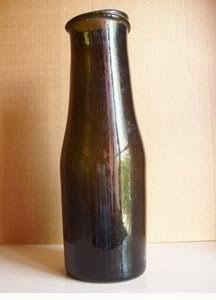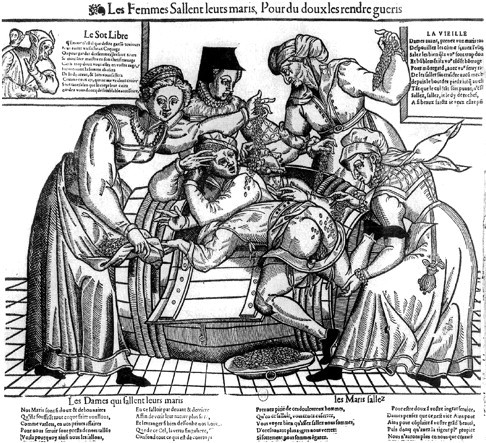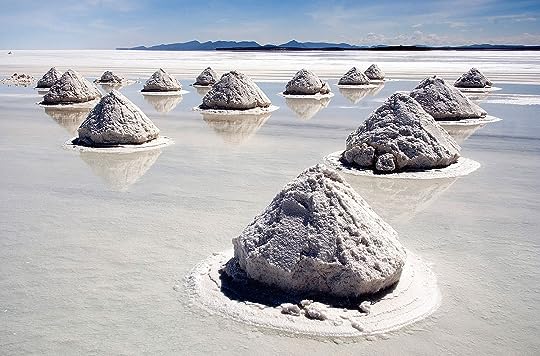What do you think?
Rate this book


484 pages, Paperback
First published January 31, 2002

In the Pyrenees, bridal couples went to church with salt in their left pockets to guard against impotence. In some parts of France, only the groom carried salt, in others only the bride. In Germany, the bride’s shoes were sprinkled with salt.



عثرت على هذا الكتاب فى سور الازبكية يوم السبت الماضى فى معرض الكتاب واشتريته بخمسة جنيهات بعدما ترددت فى شرائه فقد قرأت مقدمته ثم تركته وذهبت ولم يطاوعنى قلبى فعدت اليه مرة اخرى فاشتريته ، ...
هو عن تاريخ الملح ..تلك المادة البلورية البيضاء التى لها لون الثلج التى نستحدمها فى المطابخ وعلى موائد الطعام عدة مرات يوميا ً ..تلك المادة سريعة الذوبان التى لا يتخيل احد عدد الدول التى ' ذابت ' فى التاريخ من أجلها ..تلك المادة سهلة الضياع فى الماء .التى كانت سببا فى ضياع دماء الملايين من البشر من أجل الفوز بها
" صورة مكبرة لحبيبات من الملح "
كانوا قديماً عندما يريدون تعظيم شىء ما ومنحه الثناء والدلالة على أهميته يصفونه بأنه ' ملح الأرض ' أو ' ملح البلد ' أى كما أن الطعام يصبح ثقيلا كدرا ' ماسخا ' لا طعم له بدون الملح كذلك فإن الدنيا تصبح ماسخة ثقيلة كدرة بدون وجود ذاك الشخص الذى يدور حوله الكلام
من هنا يمكن لها ان نفهم تلك العبارة الشهيرة التى وردت على لسان سفيان الثورى رحمه الله وهو يصف جمعاً من العلماء
كان من عادة سفيان الثوري (97 - 161هـ) أن لا يُعَلّمُ أحدا العلم حتى يتعلم الأدب، ولو عشرين سنة! وكان يقول لطلاب العلم: «إذا فسد العلماء، فمن بقي في الدنيا يصلحهم؟ ثم ينشد قائلا: يا معشر العلماء يا ملح البلد ما يصلح الملح إذا الملح فسد؟!»...اى يا من وظيفتكم ان تعطوا للدنيا طعماً كما يفعل الملح مع الطعام..يامن مهمتهم حفظ عقول الناس وقلوبهم من أن يتسرب إليها العفن والتحلل كما يفعل الملح مع الطعام ..لو فسدتم من أين يتأتى الإصلاح ؟
حبيبات ملح بنية من جبال الهمالايا 
الكاتب يبدأ بتعريف الملح وطرق استخراجه (كشط البحيرات والشواطىء وتسخين ماء البحر وتبخيره ) وتركيبته الكيمائية ثم يعرج على أهميته فى الحضارات القديمة واستخداماته العديدة جدا والخرافات المرتبطة به التى حولته فى نظر القدماء إلى شىء أشبه بالسحر ثم يبدأ الكتاب بالكلام حول الصراعات التى دارت حول الملح ..حول الدول التى انهارت فى صراعات السيطرة على مصادر الملح وطرق تجارته ..
فى خلال تاريخ الانسان الطويل على الارض ربما لم يرتبط وجوده بمادة كما حدث مع " كلوريد الصوديوم " = الملح , فمنذ ان عرف الانسان حياة الاستقرار لم يستطع ابداً ان يتخلى عن الملح وشكلت هذه المادة جزءا اساسياً من حياته ,فهو يحتاج اليها للطعام وتعويض الجسم بما يحتاجه من مواد اساسية تدخل فى تكوين الدم ثم فى مرحلة ثانية احتاج اليها لتخزين الطعام وحمايته من الفساد
بدأ الامر من الصين , ففى الالف الاولى قبل الميلاد فى المناطق المجاورة لبحيرة "يوتشينج " دارت معارك كثيرة جداً للاستيلاء والسيطرة على أقدم مصنع معروف فى التاريخ لانتاج الملح , وكان الملح آنذاك سلعة اساسية احتكارها يضمن الثروة والقوة , و كما هى عادة الصينين فى الابتكار والاختراع فقد استخدموا الملح فى صناعة " المخللات , وحفظ الاطعمة بالتمليح "
أما فى مصر القديمة فقد استخدموه استخدام آخر لحفظ الجثث والمومياوات عن طريق استخدام كميات كبيرة من الملح وحشوها داخل الجسم لتجفيف السوائل الموجودة فيه وتشبع مسام الجلد بالملح الذى يمثل اداة ممتازة لمقاومة التعفن والتحلل وكما استخدموا الملح لحفظ لحوم " جثثهم " استخدموه ايضاً لحفظ لحوم الاسماك = الاسماك المملحة التى تبدو على كل حال اختراعاً مصرياً خالصاً لم تزل رائحته المميزة تزكم الانوف فى شهر ابريل من كل عام فى شم النسيم
اما الفينيقيون فهم ايضاً قاموا بدورهم فى تاريخ الملح الطويل فقد جعلوا الملح سلعة عالمية , فهم نجحوا فى ترويجه فى العالم عن طريق اساطيلهم البحرية الشهيرة التى كانت تجوب العالم القديم حينذاك فى كل لحظة , فقد استخدموه كاداة للمقايضة وتبادل السلع عبر موانىء العالم المشهورة قديما , وكان الفينيقيون يستخدمونه بكثرة ممزوجاً مع قشر الرمان للصباغة التى اشتهروا بها, وكذلك فى دباغة الجلود
ذكر الرحالة العربي ابن بطوطة أنه زار مدينة تاغرا الأفريقية في العام 1352 المبنية من الملح بما في ذلك مسجدها ، وكان الملح انذاك يستخدم كسلعة بالغة االاهمية لدرجة ان بعض قبائل افريقيا كانت تقايض كميات الملح بالذهب الخالص .
قوافل نقل الملح فى اثيوبيا * 
اما الرومانيين فقد ادركوا مبكرا قيمة الملح واهميته , فلم يترددوا لحظة فى الاستيلاء والسيطرة على ورش الفينيقيين لانتاج الملح والتى كانت تنتشر عبر شواطىء المتوسط , و فى خلال هذه الفترة أُضيفت بعض التقنيات الجديدة فى هذا الزمان لحفظ الخضار والزيتون عن طريق الملح
للاسف تبدو الاسماك والحيتان الفئة الوحيدة الاكثر تضرراً فى ذلك التاريخ الطويل للملح وتطورات استخدامه , فى القرن الثامن عشر والتاسع عشر فى اوج ازدهار عصر النهضة الاوربية كانت القارة البيضاء العجوز تنوء بحملها المتزايد من السكان وكانت فى امس الحاجة الى سد حاجتهم المتنامية الى الطعام عن طريق الاسماك فظهرت حملات واسعة للصيد فيما وراء البحار فى المحيطات الواسعة حيث الاسماك الوفيرة والانتاج الغزير , لكن هذه الرحلات تستغرق اياماً واسابيع للوصول الى هذه الاماكن ثم العودة مرة اخرى بما تم صيده الى الشواطىء الاوروبية وهذه المدة كانت كافية لافساد وتعفن اى كمية يتم اصطيادها من الاسماك مباشرة , و كان حل هذه المعضلة يتمثل فى " الملح " فى تلك الاسماك المملحة المقددة اللذيذة التى يتم حشوها بالملح بعد صيدها مباشرة لمنع اى تحلل او تعفن يظهر عليها .
من ناحية أخرى كانت الرحلات الكشفية الاستعمارية الاوروبية فى أوج ازدهارها فى هذا العصر , وكانت الشواطىء الأوروبية تقذف الى البحار يومياً الالاف من المغامرين الصعاليك الذين خرجوا بحثاً عن الثروة والذهب فيما وراء البحار و كانت هذه الرحلات تظل ايضاً شهورا طويلة فى عرض البحر تبعد عن اقرب مركز للامداد والتموين بالآف الكيلومترات وفى نفس الوقت لايمكنها الاحتفاظ بالطعام الذى غالباً ما يلبث فترة يسيرة الا ويظهر عليه اثار التعفن والتحلل , من هنا ظهرت الحاجة الملحة لاستخدام الملح فى تخليل الفواكه والاسماك لاستخدامها فى هذه الرحلات الطويلة وكل ذلك طبعاً باستخدام الملح .
فى ظل هذه الحملات الضخمة لصيد الاسماك والحيتان سواء لسد العجز الغذائى فى اوروبا او للصناعات الغذائية القائمة على التخليل والتمليح ظهرت حملات مجنونة غير منضبطة وجائرة للصيد حصدت فى طريقها كثير من انواع الاسماك التى تعرضت للانقراض والاختفاء كل ذلك بفضل وتشجيع هذه التقنيات الجديدة 'حفظ الطعام بالملح' .ِ ..كان التعفن السريع للسمك هو حجر العثرة الذى يقف فى وجه حملات الصيد الجائرة فلما ظهرت تقنية الاسماك المملحة انطلقت حملات الصيد الجائر بلا ضابط ولا رقيب.
بحيرات الملح فى بوليفيا = امريكا الجنوبية 
حينما وصل الاوروبيون الى القارة البكر = قارة الهنود الحمر او القارة الامريكية كما اطلق عليها بعد ذلك , كان السكان الاصليون يعرفون جيداً انتاج الملح لاستخدامتهم اليومية عن طريق شواطىء البحار , ولم يلبث الاوربيون قليلاً حتى اطلقوا حملات واسعة لاستكشاف اماكن تواجد الملح فى القارة الجديدة و لم تتوانى هذه الحملات عن قتل وتدمير السكان الاصليين من اجل السيطرة على الملح كما فعلوا من اجل السيطرة على الذهب وعلى كل مقدر من مقدرات هذه القارة الخضراء , لكن مقاليد الامور كانت وقتها فى يد بريطانيا التى كانت تتقاسم الحكم فى امريكا مع فرنسا , فلم تتطور هذه الصناعة فى امريكا كثيراً فحاجة السكان من الملح كان يتم توفيرها عن طريق استيراد الملح من مدينة الملح البريطانية الاشهر حينذاك = ليفربول , الذى كان ملحها يحتل مكانة وسمعة طيبة انذاك فى العالم كملح عالى الجودة ( ملح ليفربول ) ,على مدار السنوات التالية لم يكن التجار الامريكيون يرتاحون كثيراً لفكرة الحكم البريطانى لامريكا ,
وبدأ البريطانيون في عام 1759 يواجهون الميل الأميركي للاستقلال بفرض تعريفات وضرائب عقابية على التجارة الأميركية تطورت إلى حالة تمرد وحرب عام 1775، وفرض حصار بريطاني على المستوطنات الأميركية المتمردة أدى إلى نقص فوري وخطير في الملح، واستهدفت المعارك والصراعات بين الجانبين مصادر الملح، وحاول كل طرف حرمان خصمه منها. وبدأت الإدارة الأميركية المستقلة على الفور في جملة من السياسات والإجراءات تشجيع صناعة الملح ومواجهة نقصه الحاد والحصار البريطاني، فشكل الكونغرس لجانا للمشورة في طرق ووسائل إمداد الولايات المتحدة بالملح، وأعفي العمال العاملون في مجال الملح من الخدمة العسكرية، وواجه الصيادون والمزارعون أزمة خانقة في الحصول على الملح.وفي اتفاقية باريس من سبتمبر/ أيلول عام 1783 انتهت الثورة الأميركية بالاستقلال، وولدت أمة جديدة مع ذاكرة مرة عما يعنيه الاعتماد على الآخرين للحصول على الملح.
تطرق الكاتب أيضا إلى الثورة الفرنسية وشنق لويس الرابع عشر الذى كانت سياساته الم��لية الفاشلة سببا فى اندلاع الثورة ضده فى أرجاء فرنسا ، واحد أهم هذه السياسات المالية السيئة هى ضريبة ' الغايبل ' أو ضريبة الملح التى سجنت الحكومة الالاف من المواطنين حينما حاولوا التهرب منها ..قامت الثورة وكانت هذه الضريبة من أوائل الضرائب التى تم إلغاءها فورا بعد الثورة .
" الكيميا غدارة"
ربما كان هذا التعليق هو الانسب لتوصيف حالة الملح بعد ان غدرت به الكيمياء , فى السنوات الاخيرة تراجع دور الملح كثيرا وفقد قدرا كبيرا من سلطته وسطوته , عدد ليس بالقليل من المجالات التى كان يستخدم فيها كلوريد الصوديوم تم استبداله فيها بالكثير من المركبات الكيمائية الاقل سعراً وكلفة
فى الواقع يمكن لنا ان نتحدث عن ضربتين موجعتين تلقاهما الملح فى العصر الحديث افقدتاه كثيراً من اهمتيه , الضربة الاولى كانت على يد الطاهى الفرنسى الشهير نيقولاس أبير، الذي اخترع “التعليب” ، فيما الضربة القاصمة الثانية جاءت من صناعة الثلج، حيث انتشر تجميد الاسماك واللحوم ب��لا من تمليحها..
الملح واستخراجه فى الهند
فى الفصول الاخيرة من الكتاب تناول تاريخ الملح فى الهند , سيطرت بريطانيا على الهند فى القرن السادس عشر ولم تلبث قليلا حتى احتكرت تماماً صناعة الملح وتجارته فى شبه القارة الهندية فاالحكومة البريطانية منعت حتى كشط الملح عن سطح التربة تحت طائلة عقوبات قاسية، ومنعت شعوبا كانت تعتمد بأكملها على صناعة الملح والاتجار به من مواصلة عملها الذي اعتادت عليه آلاف السنين , فى العصر الحديث وخلال الثورة الهندي�� ضد بريطانيا قاوم الهنود مبدأ احتكار بريطانيا لصناعة الملح وقام عدد من زعماء الثورة بالسير لمسافة تزيد 500 كيلو سيرا على الاقدام للوصول الى شواطىء الهند من اجل استخراج الملح كنوع من التحدى لبريطانيا وبعد حملة من الاعتقالات واحتجاجات واسعة سمحت حكومة الاستعمار للهنود باستخراج الملح وصناعته من اجل حاجتهم الخاصة فقط ثم لم تلبث الهند قليلا بعدها حتى حصلت على استقلالها الكامل
__________________________
من الاشياء التى ينبغى التعليق عليها
هى ان الكاتب فى معرض سرده لتاريخ الملح فى الاديان ذكر ان الملح يحتل مكانة خاصة فى الديانة اليهودية والمسيحية ثم اضاف اليها الاسلام
بيد اننا لا نستطيع ان نوافق المؤلف فى ما ذهب اليه , فكل من له ادنى معرفة بالاسلام وبشرائعه يعلم ان الملح لا يحتل مكانة دينية ولا حتى شعائرية فى الاسلام , وان استخدام بعض الجهلة من المسلمين للملح كمادة للحفظ من الحسد والرقية وما الى ذلك هو نوع من البدع والخرافات التى لا علاقة للاسلام بها ..
لا تكون الامة اكثر فقرا الا عندما تبدو مكتظة بالاثرياء
The Roman army required salt for its soldiers and for its horses and livestock. At times soldiers were even paid in salt, which was the origin of the word salary and the expression "worth his salt" or "earning his salt". In fact, the Latin word sal became the French word solde, meaning pay, which is the origin of the word, soldier.Perhaps you can see that I thought at least parts of this book are 5-stars. Unfortunately, there are also parts - though far fewer - that, for me, were a bit of a slog. Overall, I think this is 4-stars, perhaps a bit above the middle of that group.
It became a requirement of prosciutto di Parma that it be made from pigs that had been fed the whey from Parmesan cheese. Less choice parts of pigs fed on this whey qualified to be sent to the nearby town of Felino, where they were ground up and made into salami. (The word salami is derived from the Latin verb to salt)
For a time, the Hanseatics were well appreciated as honorable merchants who ensured the quality and fought against unscrupulous practices. They were known as Easterlings because they came from the east, and this is the origin of the word sterling, which meant "of assured value."
They also ate a great deal of salted herring, though they seem to have preferred lightly salted and smoked red herring, perhaps because of their limited salt supply. When these early settlers hunted, they would leave red herring along their trail because the strong smell would confuse wolves, which is the origin of the expression red herring, meaning "a false trail."